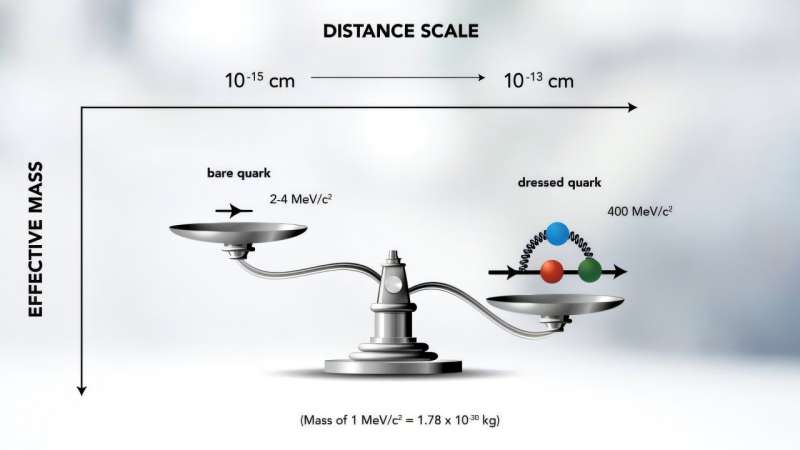Science
Experiments Shed Light on How Most Visible Mass in Universe Emerges

Significant advancements have been made in understanding how the majority of the universe’s visible mass is generated, particularly through the study of hadron mass at the Thomas Jefferson National Accelerator Facility (Jefferson Lab). On November 18, 2025, researchers highlighted findings that delve into why protons and neutrons, which are made of quarks, possess masses much larger than the sum of their parts.
The concept revolves around the strong interaction described by quantum chromodynamics (QCD). While quarks acquire their bare mass through the Higgs mechanism—an idea validated by experiments at the CERN Large Hadron Collider that earned Peter Higgs a Nobel Prize in 2013—it only accounts for less than 2% of the mass of protons and neutrons. According to Victor Mokeev, a staff scientist at Jefferson Lab, “This clearly demonstrates that the dominant part of the mass of real-world matter is generated through another mechanism, not through the Higgs. The rest arises from emergent phenomena.”
The mystery of this unaccounted mass has long perplexed nuclear physicists. However, researchers at Jefferson Lab are now gaining unprecedented insights into the processes responsible for generating hadron mass. This phenomenon, termed the emergence of hadron mass (EHM), reveals that the strong interaction generates mass from the energy stored in the fields of quarks and gluons.
Progress in Understanding Emergence of Mass
Over the past decade, scientists have made significant strides in elucidating the mechanisms behind the universe’s visible mass. This progress has been driven by studies utilizing the continuum Schwinger method (CSM), a QCD-based approach. By bridging CSM with experimental findings, researchers have analyzed nearly 30 years of data collected at Jefferson Lab, culminating in insights that have been featured in the journal Symmetry.
“This is more than what you’d see from a single experiment or set of experiments,” stated Daniel Carman, an experimental nuclear physicist at Jefferson Lab. “This is the payoff from what we’ve been doing at Jefferson Lab for decades. We still have a lot of work ahead, but this marks a major milestone along the way.”
The dynamics of QCD describe the interactions of quarks and gluons, which are the building blocks of all hadronic matter, including protons and neutrons. A key aspect of the strong force is gluon self-interaction. Mokeev noted, “Without gluon self-interaction, the universe would be completely different. It creates beauty through different particle properties and makes real-world hadron phenomena through emergent physics.”
New Insights from Experimental Data
The evolution of strong-interaction dynamics is effectively described within the CSM. At distances comparable to the size of a hadron (approximately 10-13 cm), the constituents are no longer the bare quarks and gluons of QCD. Instead, dressed quarks and dressed gluons emerge, surrounded by clouds of strongly coupled quarks and gluons that are in a continuous cycle of creation and annihilation.
This leads to dressed quarks acquiring dynamically generated masses that evolve with distance. For instance, the mass of a dressed quark can increase from a few MeV to about 400 MeV, contributing to the overall mass of a proton, which is around 1 GeV. The findings raise important questions regarding whether EHM can be further clarified by mapping the momentum dependence of the dressed-quark mass through experimental data.
The Continuous Electron Beam Accelerator Facility (CEBAF) at Jefferson Lab, a U.S. Department of Energy Office of Science user facility, plays a crucial role in this research. It produces high-intensity electron and photon beams, with energies reaching up to 12 GeV, directed at nuclear targets across four experimental halls. Within Experimental Hall B, the CEBAF Large Acceptance Spectrometer for 12 GeV (CLAS12) stands as a significant asset, enabling detailed studies of particle interactions.
Research using data from CLAS and its predecessor, CLAS, has allowed scientists to probe the structure of protons and their excited states in unprecedented detail. These findings can be directly compared with theoretical predictions from CSM, facilitating a deeper understanding of EHM.
“This kind of work requires synergy between experiment, phenomenology, and theory,” Carman explained. “You need all of these different contributors working together in close collaboration to get at the physics we’re trying to uncover.”
As researchers look ahead, Mokeev emphasized the ongoing need for further exploration. Experiments conducted during the previous 6 GeV era of CEBAF examined the momentum range that accounts for about 30% of hadron mass. Current efforts in the 12 GeV era aim to extend this coverage to approximately 50%, while future experiments with higher-energy electron beams promise to enhance understanding of the distance domain where most hadron mass originates.
“When we get this information from the data of future experiments, we will be able to map out the full range of distances where the dominant part of hadron mass and structure emerge,” Mokeev concluded.
The ongoing investigations at Jefferson Lab not only advance the field of nuclear physics but also bring scientists closer to unraveling one of the universe’s most fundamental mysteries—the origins of mass.
-

 Entertainment3 months ago
Entertainment3 months agoAnn Ming Reflects on ITV’s ‘I Fought the Law’ Drama
-

 Entertainment4 months ago
Entertainment4 months agoKate Garraway Sells £2 Million Home Amid Financial Struggles
-

 Health3 months ago
Health3 months agoKatie Price Faces New Health Concerns After Cancer Symptoms Resurface
-

 Entertainment3 months ago
Entertainment3 months agoCoronation Street’s Carl Webster Faces Trouble with New Affairs
-

 Entertainment2 months ago
Entertainment2 months agoWhere is Tinder Swindler Simon Leviev? Latest Updates Revealed
-

 Entertainment4 months ago
Entertainment4 months agoMarkiplier Addresses AI Controversy During Livestream Response
-

 Science1 month ago
Science1 month agoBrian Cox Addresses Claims of Alien Probe in 3I/ATLAS Discovery
-

 Entertainment4 months ago
Entertainment4 months agoKim Cattrall Posts Cryptic Message After HBO’s Sequel Cancellation
-

 Entertainment2 months ago
Entertainment2 months agoOlivia Attwood Opens Up About Fallout with Former Best Friend
-

 Entertainment3 months ago
Entertainment3 months agoMasterChef Faces Turmoil as Tom Kerridge Withdraws from Hosting Role
-

 Entertainment4 months ago
Entertainment4 months agoSpeculation Surrounds Home and Away as Cast Departures Mount
-

 World2 months ago
World2 months agoCole Palmer’s Mysterious Message to Kobbie Mainoo Sparks Speculation





















